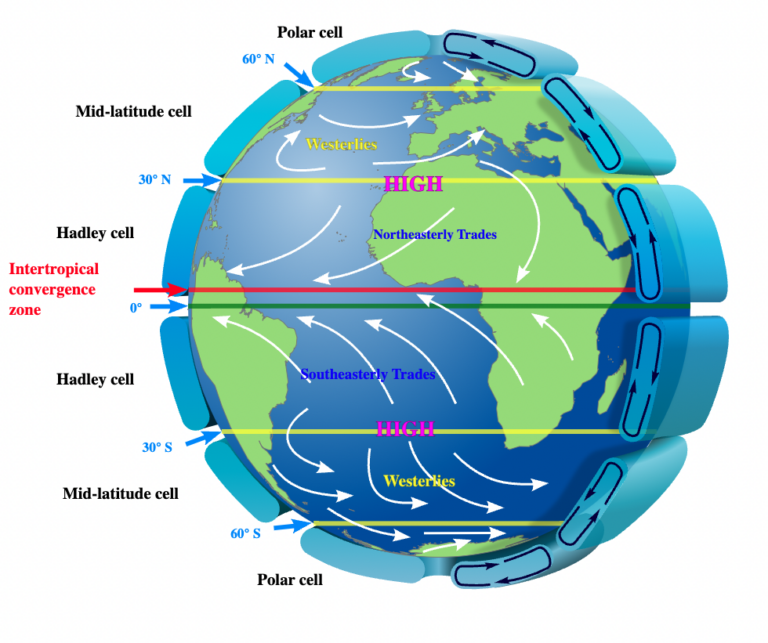
Close

The wind energy industry heavily relies on comprehending diverse wind patterns to optimize energy production and turbine performance. While local winds provide site-specific data, general circulation winds operate on a global scale and are pivotal for macro-level planning and forecasting.
In this post, we will explore how global wind patterns impact the wind energy industry by providing a comprehensive understanding of how wind moves around the Earth—an essential factor for the development and optimization of wind energy resources.
General circulation winds are large-scale wind systems generated by the Earth’s rotation and the uneven heating of its surface by the sun. These winds are governed by three primary atmospheric circulation cells:

Idealised depiction (at equinox) of large-scale atmospheric circulation on Earth. By Kaidor – Own work based on File: NASA depiction of earth global atmospheric circulation.jpg, CC BY-SA 3.0.
Major atmospheric cells are also influenced by the Coriolis effect, a force caused by the Earth’s rotation that deflects north-moving winds to the east in the Northern Hemisphere and to the west in the Southern Hemisphere. These winds govern global weather patterns and include the following major wind types:
1. Trade Winds:
Trade winds are consistent winds that blow from east to west in tropical regions, typically between 30 degrees north and 30 degrees south latitude. They are driven by the Hadley cell, a circulation pattern where warm air rises near the equator, moves poleward at high altitudes, and descends in subtropical regions.
Relevance to the Wind Industry:
2. Westerlies:
Westerlies are prevailing winds that blow from west to east in the mid- latitudes (30 to 60 degrees latitude in both hemispheres). These winds are particularly strong during winter and are associated with cyclonic weather systems.
Relevance to the Wind Industry:
3. Polar Easterlies:
Polar easterlies are cold, dry winds that blow from east to west in high- latitude regions near the poles. They originate from the polar high-pressure areas and flow toward lower latitudes.
Relevance to the Wind Industry:
4. Jet Streams:
Jet streams are high-altitude wind currents that flow at speeds of up to 300 km/h near the tropopause, the boundary between the troposphere and the stratosphere. They form at the convergence of warm and cold air masses.
– Polar Jet Stream: Situated between 50 and 60 degrees of latitude, these winds exhibit their peak strength during the winter months. They significantly influence the trajectories of storm systems and weather patterns in mid- latitudes.
– Subtropical Jet Stream: Positioned approximately 30 degrees of latitude, these winds exhibit a generally lower magnitude compared to the polar jet stream. Nevertheless, they still contribute to the formation and evolution of large-scale weather patterns.
Relevance to the Wind Industry:
Cross section of the subtropical and polar jet streams by latitude.
By Original: National Weather Service JetStream Vector: Sleske – Own work based on: Jetcrosssection.jpg, CC BY-SA 4.0.
General circulation winds, characterized by their broad and steady patterns, can exhibit variability due to localized factors such as topography and atmospheric conditions.
Linear Flow:
In open regions like oceans or plains, general circulation winds exhibit smooth and uniform flow. Linear flow ensures stable energy generation and reduces wear on turbine components.
Turbulence:
Near coastlines, mountains, or urban areas, general circulation winds can become turbulent. Turbulence impacts turbine efficiency and increases maintenance requirements.
Relevance to the Wind Industry:
In conclusion, a comprehensive understanding of general circulation winds is essential for the wind energy industry to optimize energy production, enhance turbine performance, and ensure efficient site selection. Understanding general circulation winds is vital for macro-level planning, as it helps identify regions with reliable wind resources for large-scale projects. It also plays a crucial role in forecasting by enabling the development of accurate models to predict both seasonal and long-term wind patterns. Additionally, understanding these winds is essential for risk mitigation, allowing the anticipation of shifts in global wind behavior due to climate change and the adaptation of strategies accordingly.
Modeled wind resource data for the wind industry.
At any site around the world. Onshore and offshore.